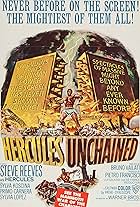This is another splendid peplum (actually the director's entry into the field he would revisit 6 more times) vastly undersold by the "Leonard Maltin Film Guide", which he rates at a mere **. That said, I managed to acquire and watch a widescreen print in Italian (albeit somewhat worn and with virtually illegible credits!), and could not picture it English-dubbed and panned-and-scanned afterwards – which may well be how many foreigners caught the film, on TV, to begin with...and, in fact, it has frequently aired on the U.K. channel "Movies 4 Men" this last year! Anyway, it re-unites Gianna Maria Canale and Georges Marchal from Riccardo Freda's equally fine THEODORA, SLAVE EMPRESS (1954), though the two do not actually meet face-to-face here – as the passage of just 4 years had relegated the former (despite receiving top-billing) to a villainess role and the latter to second lead! The hero, then, is Ettore Manni who would virtually become synonymous with the genre (in fact, he appeared two more times for Cottafavi) and, in this case, is possibly at the very top of his game.
Its deceptively-brief running-time of 82 minutes betrays a busy and rather complex plot (whose essence neither the bland English title nor the prosaic original, translating to THE REVOLT OF THE GLADIATORS, can really hope to capture!) that sees the Romans, led by Manni, taking on two different countries that rarely featured in this type of fare – the Armenians and the Shi'ites. Canale is the aspiring Queen of the former (the official ruler is a child whom she is slowly poisoning to death!), ingratiating herself with the conquerors in order to keep her status (but subsequently conspiring with the latter people so as to regain the upper hand), while Marchal is the rugged leader of a rebel Armenian army – who has lived much of his life fighting, either in the gladiatorial arena or for his country's freedom. There are several twists-and-turns along the way which has all the protagonists going from victor to vanquished (the hero's hatred of injustice and display of clemency towards the barbarians actually brings about the titular rebellion!): more importantly, following the obvious initial enmity, Manni and Marchal eventually earn one another's respect and, through a mutual understanding, join forces against a common enemy.
Similarly, an Armenian girl whose father had been killed by the Romans and ends up as Canale's slave (her knowledge of medicine even results in the little King's recovery!), is confounded by her feelings for Manni but, by the end, the two are at each other's side (in fact, rather than the standard anonymous long-shot of the landscape, Cottafavi emphasizes the intimacy of the narrative by sticking with them, silent observers to Marchal's funeral procession, for the closing shot). Indeed, such sturdy film-making abounds in this outing (in direct contrast to the director's two subsequent juvenile adventures featuring the mythical Greek demi-god Hercules!)...but, as with his picaresque masterpiece THE HUNDRED HORSEMEN (1964), we also get a mischievous dwarf thrown into the fray for (thankfully not over-stressed) comic relief purposes! Other memorable scenes here include: Marchal's duel in the arena with a lion; Canale's demise at the hands of one of her escaped pet tigers; Manni getting virtually single-handedly freed from prison by his devoted strong-man lieutenant (hilariously, the midget is thought to have thrown a guard clear across the room when it was really him!) but who pays the price with his life – incidentally, both he and Marchal also have strong-minded female companions (which is quite atypical of the genre!); and the heroine being herself saved from the stake at the proverbial eleventh-hour by her lover.





































